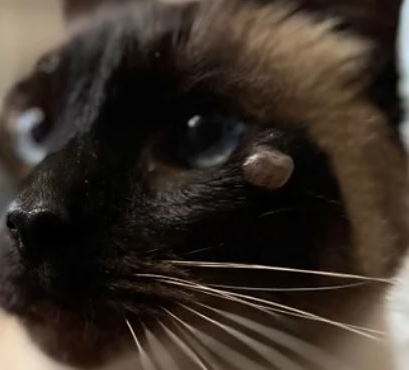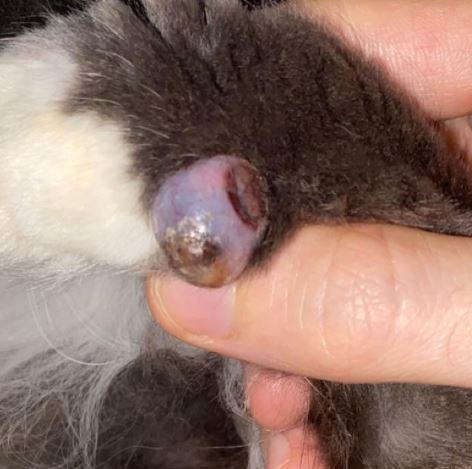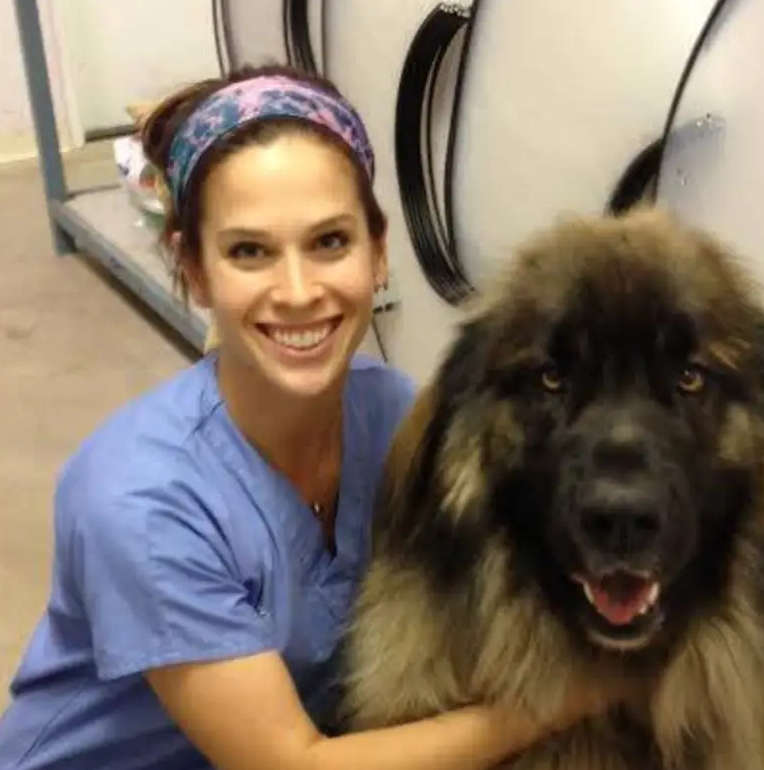What is a cyst, and why does it need to be drained?
A cyst is a small, non-cancerous, pimple-like growth on the skin. There are several types of cysts in cats (Read our article: Types of Cysts in Cats – With Pictures) The most common type of cyst found in cats is a sebaceous cyst. Sebaceous cysts occur when dirt, debris, oil, or infection becomes trapped in your cat’s hair follicle.
Often owners miss them because they hide under their cat’s hair. In fact, as a veterinarian, I typically see cysts in cats after they rupture (bleed or ooze) or when they become very large. Since it’s easy for owners to miss small lumps, I recommend they do a monthly skin exam to check for new lumps or bumps.
New lumps can sometimes be benign, but they can also be cancerous. Routine skin checks help identify suspicious lumps early, which provides the best outcome for your cat. In this article- we will discuss sebaceous cysts and how you and your veterinarian can work together to prevent, manage, and treat them.
Related post: Performing monthly checks on your cat.
What happens if my cat’s cyst is not drained?
Sebaceous cysts usually do not cause any issues. Sometimes they drain themselves or even disappear without treatment. However, cysts should always get checked by a veterinarian. Untreated sebaceous cysts can turn into squamous cell carcinoma (skin cancer) or cause infection. Squamous cell cancer is the most common type of skin cancer in cats. It forms when a cat is exposed to prolonged UV light (aka the sun).Pay attention to cysts that grow larger or change over time. Cysts that change rapidly or grown suddenly could be cancerous.
Sebaceous cysts that have any of the following characteristics should be checked by your veterinarian immediately:
- Red
- Irritated
- Bloody
- Oozing
Pictured below: A cat with a large sebaceous cyst above his eye.

Pictured below: Large cyst on a cat. A cyst that needs surgical treatment.

How do I know when it’s time to drain a cyst?
All new lumps should get checked by your veterinarian. Sebaceous cysts should be drained or removed if they appear with any of the following symptoms:
- Bleeding
- Yellow or green crusts
- Redness
- Irritation
- Itching
When is a cyst a reason to be concerned?
Sebaceous cysts are generally harmless. However, there is a chance that a cyst on a cat can be a sign of something dangerous. You should be concerned about a cyst that is getting larger, or has ruptured. You will also want to keep an eye out for symptoms of other skin issues in cats. For example, some cancerous skin tumors look similar to sebaceous cysts.
Lets take a look at a few of them:
Squamous cell carcinoma:
This cancer affects cats that spend a lot of time in the sun. Cats will develop small lumps that can spread to the lungs and lymph nodes. Untreated sebaceous cysts can turn into sebaceous cell carcinoma.
Basal cell carcinoma:
Basal cell carcinoma is a cancerous skin tumor found in cats. It causes small nodules that look similar to a sebaceous cyst. They commonly appear on the cats back, chest, and head.
Melanoma:
Melanoma is a type of skin cancer found in cats. It causes lumps that are dark in color and sometimes bleed. Tumors caused by melanoma can look similar to a sebaceous cyst.
How do vets drain cysts? (steps of the procedure)
- Your vet will begin by preparing the area around the cyst by shaving it and scrubbing it with an antibacterial solution.
- They will insert the needle into the cyst and pull back the plunger. If the fluid inside the cyst is thin enough, it will fill up the syringe. Your vet will repeat this process until there is no more fluid in the cyst.
Note: not all cysts will can be drained. Many cysts contain a discharge that is too thick to drain this way. Cysts that contain thick discharge need to be surgically removed.
Can you drain a cyst yourself at home?
If your cat’s cyst is visibly draining- you can apply a warm towel to help the cyst to drain more smoothly. However, it is never a good idea to squeeze a cyst.
Draining a cyst at home could cause:
- Worsening of the cyst
- Infection
- Severe Inflammation
- Pain
When is it time to schedule an appointment with my vet?
A sebaceous cyst is usually not an emergency. However, all sebaceous cysts be seen by a vet. If your cat is showing any of the following symptoms, you should visit a vet as soon as possible. These are signs that your cat may have an infection or a cancerous skin tumor:
- A cyst that is growing rapidly
- A cyst that ruptures
- Pain
- Bleeding
- Oozing
- Itching
What can I do before my vet appointment?
If your cat has a sebaceous cyst and it is infected or draining, you can try the following things before you visit the vet:
- Keep the area clean: This one is important, particularly if your cat has a cyst that has burst. Ruptured cysts may be leaking fluid or bleeding. In this case, you can clean the cyst with a mild salt solution and gentle pressure. You can also use powder-free litter or shredded paper to prevent foreign material from entering the wound and causing infection. At our practice, we use shredded newspaper, paper towels, or a pelleted litter called Fresh News.
Note: many cats have a hard time adjusting to changes in cat litter. If your cat has trouble adjusting, you can try- mixing pelleted cat litter with their usual cat litter. Remember to clean the cyst each time your cat uses the litter box.
- Protect the cyst from self-harm with an e-collar: Many cats scratch and lick at wounds. E- Collars (Elizabethan collars) are great because they prevent scratching and licking. They block your cats access to most body parts.
For a perfect e- collar fit follow these instructions:
- Bring your cat to your vet or a local pet supply store and ask them if you can try a collar out.
- The collar should fit around the neck with 1-2 fingers space between the collar and neck. This way, the collar will not dig into the skin.
- The collar should only extend slightly beyond the nose so it can eat and drink comfortably.
- If your cat refuses to eat with the collar on, you can remove it during feeding as long as you watch them the whole time. Make sure you put the collar on as soon as they finish eating
- Apply a warm compress to the cyst: Soak a clean towel in warm water and apply it to the cyst. You can do this 2-3 times a day. Note: This is to encourage the cyst to drain without pressure. Please DO NOT squeeze the cyst, as it could cause inflammation and pain.
What is the cost to have a cyst drained your a cat?
The cost varies depending on your geographical location; and the treatment prescribed by your vet. There are many things included in the procedure. Open drainage is cheaper because your cat will not need anesthesia. Surgery is more expensive-because it includes anesthesia and monitoring.
The treatment for open cyst drainage includes:
- Exam $45-70 USD
- Cyst drainage $25-200 USD
- Microscopic examination of cyst material (included in cyst drainage)
- Lab costs to send samples of the fluid in the cyst out (Included in cyst drainage)
- Antibiotics $30-40 USD
- E-collar $10-20 USD
Note: costs may vary based on location and the treatment recommended. Biospises are not required. (but they are recommended by most vets)
Cost of surgical removal of a cyst on your cat?
The treatment for surgical removal of a cat cyst includes:
- Exam $45-70 USD
- Pre-surgical bloodwork $55-75 USD
- Cyst removal surgery $500-2,500 USD (cost depends on how long surgery takes and other factors)
- Pre-surgical medications (typically included in surgery)
- Surgical monitoring (typically included in surgery)
- Intravenous (IV) fluids (typically included in surgery)
- Lab costs to send a biopsy out are $150-700 USD (depending on the type of biopsy.)
- E-collar $10-20 USD
- Medications to go home $30-80 (antibiotics and pain)
Note: costs may vary based on location and treatment recommended. Biopsies are not required. (but they are recommended by most vets)
What’s the prognosis for a cyst on your cat?
The prognosis for a sebaceous cyst is good. Cats with recurring cysts will benefit greatly from surgical removal of the cyst and will generally heal completely within 7-14 days. However, cats that only have a cyst drained may have cysts that return.
Note: Some cats are prone to have recurring cysts, even with surgery. If this is your case, you may want to read more below under the question in this article, How can I ensure the cyst on my cat does not come back?
Are there any risks of an open drainage procedure for a cyst on your cat?
With any procedure, there are risks involved. When your vet drains a cyst, your cat will be awake. Your cat will be wiggly and maybe even upset. It will be hard to keep your cat still; and even harder to keep a sterile (germ-free) area. With open drainage of sebaceous cysts, the most significant risk is the potential for infection.
Your vet is trained perfectly for this situation and will have staff available to assist them. During the procedure, your vet will:
- Shave and disinfect the area around the cyst.
- Use sterile instruments and needles when draining the cyst.
- Provide antibiotics to prevent bacteria.
- Provide pain control for your cat.
- Provide an e-collar to prevent your cat from scratching or licking the area.
FAQ
Will my cat’s cyst come back even after draining?
Sebaceous cysts tend to reoccur. When your vet drains a cyst, they only remove the fluid. The problem is that the fluid exists in a small sack of tissue, almost like an envelope. When a cysts sac is left, it fills up with fluid until the entire cyst (including the sac) is removed.
How can you ensure the cyst on your cat does not come back?
There is no way to guarantee a cyst will not return. However, you can try to prevent them by feeding your cat a diet high in Omega acids. Omega 3 fatty acids help promote healthy sebum (oil) production in your cat’s skin. At my clinic, we have had success with this brand of Omegas.
Do cat cysts sometimes go away without having to drain them?
Yes, cysts can resorb (absorb) back into the body. However, most cysts will stay until they are removed.
Is there any alternative to draining a cyst on your cat?
Yes. Besides draining a cyst, you can wait it out- and see if the cyst goes away on its own. Or, you can have the cyst surgically removed. If you choose not to do surgery- you can try bathing your cat in a non-prescription shampoo containing benzoyl peroxide. Benzoyl peroxide can help flush your cat’s hair follicles and support healthy oil production. Some pet owners have had success using Dermabenss shampoo.
